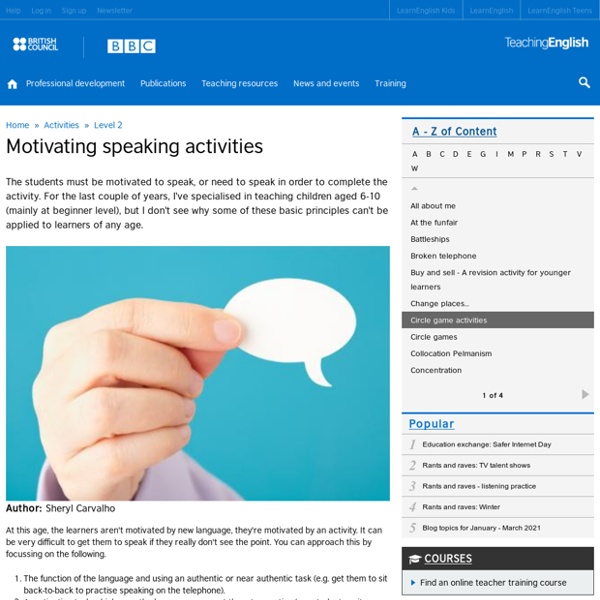Motivating speaking activities
At this age, the learners aren't motivated by new language, they're motivated by an activity. It can be very difficult to get them to speak if they really don't see the point. You can approach this by focussing on the following. The function of the language and using an authentic or near authentic task (e.g. get them to sit back-to-back to practise speaking on the telephone).A motivating task, which uses the language you want them to practise (e.g. students write questions on small squares of paper using the target language, then form the papers into a board game to be played using dice and counters). Here are some possible examples, which apply to one or a combination of the above. A popular, well-known type of activity is the information gap. Making an arrangement: Each group has a diary, with appointments already filled in. Here are some examples of other activities I use with my younger learners:
https://www.teachingenglish.org.uk/article/motivating-speaking-activities
Related: esterfeldman
• TEACHING YL ONLINE
• miss_naomi
Motivating pupils to read
This article describes ways to generate initial motivation, the second one shows how to maintain this motivation. Motivation Creating the basic motivational conditions Generating initial motivation References Motivation Motivation is one of the key factors that determine the rate and success of L2 attainment. It provides the main incentive to initiate learning a foreign language and later the determination to persevere and sustain the long and often difficult learning process. Without sufficient motivation, even individuals with the best of abilities cannot accomplish long-term goals.
Assessment for Learning
What is Assessment for Learning? Assessment Reform Group (UK 2002):Assessment for Learning is the process of seeking and interpreting evidence for use by learners and their teachers to decide where the learners are in their learning, where they need to go and how best to get there. Assessment for Learning is also known as formative assessment. What is the difference between formative and summative assessment? Activities associated with summative assessment (Assessment of Learning) result in an evaluation of student achievement - for example, allocation to a level or standard or allocation of a letter or numerical grade, which might later appear in a report. Activities associated with formative assessment (Assessment for Learning) do not result in an evaluation.
Getting teenagers to talk
Keep the conversation peer centred: plenty of pair or small group collaboration.Avoid asking discussion questions around the class: this puts them in the spotlight and causes potential embarrassment in front of friends. You also risk dominating the talk.Give them a concrete list of statements or opinions: help them to choose their own ideas. Don’t expect them to have fully formed opinions on all things teenage!
Assessment for Learning
So, what is AfL and why is it important? Can it improve students’ results? What does it involve?
Creative activities for Language Learners at home
Introduction The British Council is committed to supporting the use of technology for the continuation of education in a crisis. As many teachers find themselves in an unfamiliar situation of having to teach their classes online, with little or no experience, the British Council TeachingEnglish website is committed to providing as much support as possible to help you navigate your way through the world of online teaching. This is the seventh in our series of webinars aimed at supporting teachers working in an online context. It is also the first in a series of twelve webinars by winners of the British Council's English Language Teaching Research Awards (ELTRAs) About the webinar
Inclusive Teaching Checklist
Daniel Sobel Daniel Sobel MA Ed (Psychology) FCMI FCIC FRSA is the Founder and Lead Consultant of Inclusion Expert. An internationally respected leader in inclusive education, he has advised the Department for Education, the European Union and governments abroad. Daniel is a well-known speaker, and has written...
7 Tips For Peer And Self-Assessment
Christina Brown Christina is an Art and Design Teacher in a London secondary school. In her third year of teaching, she has also just completed an MA in Art and Design in Education at The Institute of Education (University College London). Christina is also a practicing artist...
Differentiated Instruction for Writing
What is differentiated instruction? Differentiated instruction, also called differentiation, is a process through which teachers enhance learning by matching student characteristics to instruction and assessment. Differentiated instruction allows all students to access the same classroom curriculum by providing entry points, learning tasks, and outcomes that are tailored to students' needs (Hall, Strangman, & Meyer, 2003). Differentiated instruction is not a single strategy, but rather an approach to instruction that incorporates a variety of strategies.
Related:



